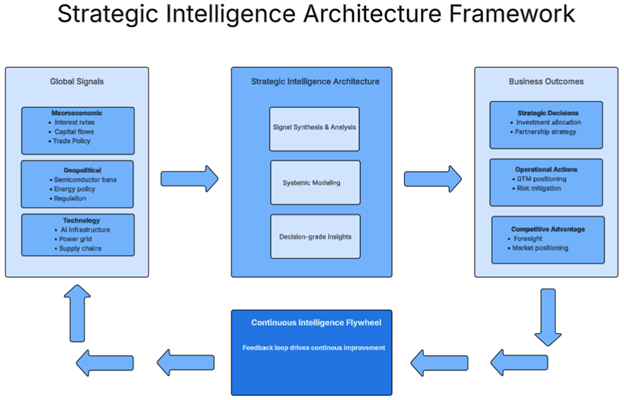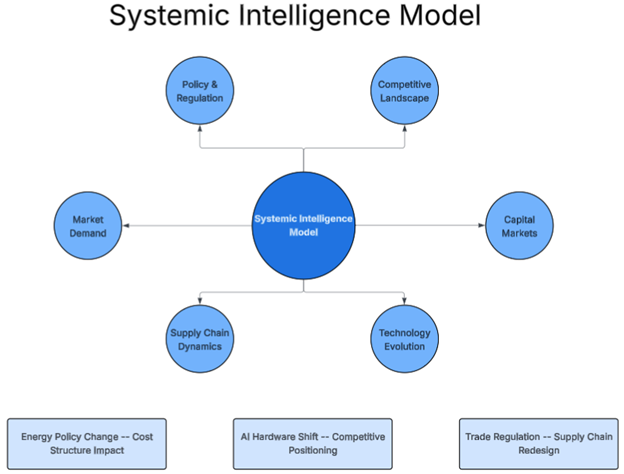Every transformation begins with a decision, and every decision depends on the quality of intelligence behind it. In an environment where technology shifts faster than strategy cycles, organizations need more than dashboards and reports. They need a way to see around corners.
At NRI, our Strategic Intelligence Architecture helps executives do exactly that, by connecting global signals to business decisions, translating complexity into clarity, and guiding investment choices before disruption forces a reaction.

Connecting Macro Signals to Organizational Strategy
Traditional market analysis treats these as separate events. Strategic Intelligence Architecture treats them as a living system.
NRI’s approach builds frameworks that link these global signals directly to our clients’ strategic priorities. We track macro trends such as AI infrastructure growth, power grid constraints, and evolving trade policy. Then we map them to business impacts: cost structure, revenue exposure, and operational risk.
For example, when data-center demand began outpacing utility capacity in North America, our intelligence models forecasted the financial and operational implications for manufacturers, utilities, and cloud service providers. Clients used those insights to shift capital allocation and secure energy partnerships before the shortage turned into a bottleneck.
The outcome was not a slide deck; it was a measurable competitive advantage.
This signal-to-strategy link is what separates intelligence from information. It enables leadership teams to see how a policy in Washington, a pricing move in Taiwan, or a supply shift in Texas can alter their next quarter’s results.
Translating Complexity into Decision-Grade Insights
The challenge isn’t the lack of data, it’s the flood of it. Leaders are surrounded by noise: quarterly reports, vendor claims, analyst opinions, and economic forecasts that rarely connect to actionable choices.
Strategic Intelligence Architecture filters, synthesizes, and translates that noise into decision-grade insights.
Our analysts combine quantitative modeling with qualitative foresight. We integrate signals from technology ecosystems (such as NVIDIA’s restructuring of compute hierarchy), macroeconomic indicators (such as interest rate pressure and capital expenditure trends), and industry-specific data. The result is not a static report but a living view of how the forces shaping tomorrow’s market are already influencing today’s operations.
For clients, that means clear visibility into where to invest, when to pivot, and how to communicate those choices to boards and investors.
This work supports everything from transformation roadmaps to go-to-market strategy. When our clients face questions about AI adoption, sustainability, or supply resilience, we help them understand not only what is happening but why, and what it will mean six, twelve, or twenty-four months ahead.
It’s intelligence built for execution, not speculation.
Guiding GTM and Investment Decisions Through Systemic Modeling
In the past, companies relied on experience and intuition to guide investment. Today, interdependencies across supply chains, regulation, and technology make intuition alone too slow and too narrow.
NRI’s systemic modeling approach connects these domains into a unified foresight system. By simulating how a single variable, say, a new energy efficiency standard or a hardware design change, affects cost, margin, and customer demand, we give executives a forward-looking model of their business environment.

These models underpin go-to-market planning, partnership strategy, and investment governance. They answer questions such as:
- How do global policy shifts alter the total cost of ownership for our products?
- Where should we focus AI and automation investments to generate margin resilience?
- Which market segments are likely to accelerate or decelerate under new regulatory or technological conditions?
When leaders can see the connections before others do, they can act with confidence. They move from reacting to shaping.
Turning Intelligence into Action
Every engagement at NRI is built around one principle: insight is only valuable when it drives action.
Our Strategic Intelligence Architecture framework doesn’t stop at analysis. It connects foresight to the field. Insights flow directly into sales enablement, client engagement, and service development. The same intelligence that informs our Quarterly Intelligence Briefings also shapes our advisory roadmaps, rate card governance, and client strategies.
This integrated approach turns intelligence into an operational flywheel: research feeds strategy, strategy guides execution, and execution produces new intelligence. Over time, our clients build institutional foresight: the ability to anticipate, adapt, and lead.
Seeing the Next Move Before It Happens
Leaders who treat intelligence as a static report end up reacting to the world. Leaders who embed Strategic Intelligence Architecture into their decision process shape it.
Whether the challenge is AI infrastructure investment, energy resilience, cybersecurity risk, or supply-chain diversification, NRI partners with executives to design a clear path from signal to strategy to action.
In a world defined by acceleration, foresight is no longer a luxury. It is the foundation of sustainable advantage. Talk to our team today!



